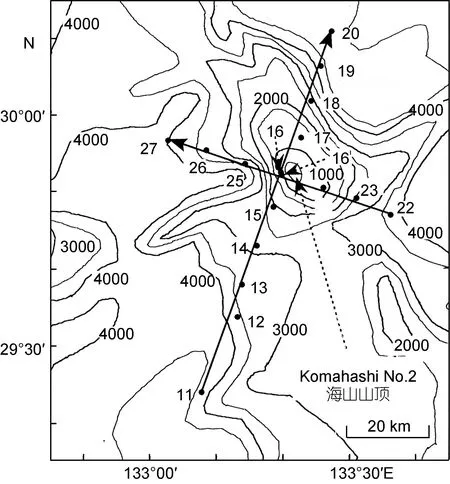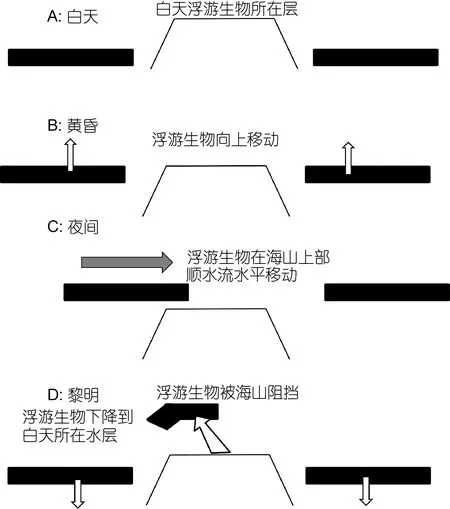海山区浮游生态学研究*
2014-03-19张武昌李超伦李学刚
张武昌 于 莹, 李超伦 李学刚 肖 天
(1. 中国科学院海洋研究所海洋生态与环境科学重点实验室 青岛 266071; 2. 天津渤海水产研究所 天津 300457)
海山镶嵌在海底, 形成明显的地理构造, 和洋流作用导致很多物理过程, 包括流路狭窄导致洋流加速、等温线变形、涡的形成、底部增强为泰勒柱(Taylor column)、内波等。这些物理过程会影响海山的生物过程。海山周围的鱼群比其周围的大洋丰富, 有的海山底栖生物也很多(Udaet al, 1958; Hubbs, 1959;Uchidaet al, 1984; Sasaki, 1986), 多年来有几个假说来解释海山区鱼类和底栖生物富集的原因, 对海山区浮游生态学的研究一直围绕着这些假说进行。
我国的海洋生态学研究正在从近海走向大洋, 本文即综述海山区浮游生态学的研究情况, 为我国海山区浮游生态学研究提供参考。
1 研究的海山及布站方法
在海山区进行的浮游生态学研究不多, 1990—1992年, CSEX计划(the Cobb seamount experiment)在Cobb海山进行了3个夏季航次。2002—2005年,OASIS(Oceanic Seamounts: an integrated study)计划在Seldo海山和Seine海山进行了综合观测。2009年3月, 在美国举办了名为“海山生物地球科学网络(seamount biogeosciences network)”的研讨会(http: //earthref.org/events/SBN/2009/sbn-09-announcement.htm), 会议发起了SEEF计划(seamount ecosystem evaluation framework, http: //www.seamounteef.org/home), 为世界的海山进行评估。
目前主要有9座海山进行了浮游生物的调查研究(表1, 图1), 这些调查的断面都通过山顶, 设置分为三种情况: 一个断面、两个垂直断面(图2)和三个放射状断面。海山调查不同于大洋调查的重要特点是站位之间的间距较小, 一般小于5海里(图2)。

图1 进行过浮游生态学调查的海山位置Fig.1 Positions of seamounts where pelagic ecologic investigations were carried out
2 经典假说
这种假说认为海山区域有比其背景大洋较高的基础生产(浮游植物初级生产力和浮游动物次级生产力)。自20世纪50年代以来, 研究者普遍认为: (1) 上升流和环流条件提高了海山上部海区的初级生产力,(2) 进而提高了浮游动物的生物量, (3) 从而支撑了较高的鱼类和底栖生物生物量(Udaet al, 1958; Hubbs,1959; Boehlertet al, 1987; Boehlert, 1988)。Dower等(1996)把这一假说称为海山浮游生态学的“经典假说(classic hypothesis)”, 并把上述海山对初级生产力、浮游动物和鱼类的影响称为“海山效应(seamount effects)”(Vilaset al, 2009)。
这个假说的核心是海山区的浮游植物生物量和生产力是否提高。海山区浮游植物生产力提高的水文动力机制是: 大洋海水层化, 上层营养盐较低, 处于贫营养状态, 海流流经海山时会产生上升流, 导致等温线升高, 深层富营养海水进入真光层, 并通过泰勒柱的作用在海山上部保持足够的时间(至少几个月)进行光合作用, 以使初级生产传递到浮游动物和鱼(Rowdenet al, 2010)。
但是水文观测表明这个机制并不总是起作用, 在8座海山(山顶距海面100—1440m不等)进行的17次观测(Geninet al, 1985; Genin, 1987)中, 不到一半的观测发现等温线上升, 只有1次观测(Geninet al,1985)发现等温线上升突破真光层、叶绿素浓度升高(Genin, 2004)。
在海山的浮游植物观测也没有一致的结果。Genin等(1985)于1984年3月13日在Minami-Kasuga海山观测到在海山上方有上升流造成的冷堆(cold dome),此处叶绿素浓度升高, 浮游动物的生物量也高, 在随后的3月15日和30日则没有观测到这一现象。这是首次研究海山对浮游生物的影响。在Great Meteor海山的模型工作显示在海山上面有一个区域与周围海域相对独立(Beckmannet al, 2002)。
盆腔肿瘤属于妇科常见病,特别是卵巢肿瘤、子宫肿瘤比较多见,但盆腔肿瘤起病隐匿或临床表现不突出,容易使得患者错过最佳诊治时间,若是未得到及时治疗,极易使得女性不育不孕,更甚至威胁到患者的安全健康[1]。CT具有较高的分辨率、灵敏度,在各类疾病诊断中广泛应用,其地位不可取代;MRI通过磁共振技术获得人体电磁信号,并重新构建人体信息,进一步监测患者病情。MRI和CT都能够帮助临床早期诊断妇科盆腔肿瘤,进一步为临床有效诊治提供可靠参考,现报道如下。

图2 Komahashi No. 2海山区的地形、生态学调查断面和站位设置(Odate et al, 1998)Fig.2 Topographic map showing transect (solid black line with arrows) and stations (black dots) of planktonic ecology investigation in area around Komahashi No. 2 Seamount (Odate et al, 1998)
研究人员于1990—1992年在Cobb海山进行了连续三个夏天的观测。1990年夏天, 高叶绿素浓度(比海山周围海水高出2—5倍)的海水在海山区持续1个月(Doweret al, 1992)。但是后面两个夏天并没有发现这种现象, 海山区和对照区(海山以外的区域)初级生产力斑块分布明显(Comeauet al, 1995)。
有研究发现, 1991年6月18—21日在Komahashi No. 2海山等温线上升区的上部, 即水深75—90m处存在叶绿素最大层, 并且山顶上游区叶绿素最大层的平均深度(87m)大于下游区域(79m)(Furuyaet al,1995; Odateet al, 1998)。
自1992年3月起, Mourino等(2001)在Great Meteor海山进行了5次调查, 发现浮游植物和初级生产与物理海洋学之间的关系在时间和空间上都有很大的变化。
Sime-Ngando等(1992)发现Cobb海山上的浮游纤毛虫丰度与周围海水的相当, 但生物量较高。
综上所述, 只有少数调查发现海山区域初级生产提高, 维持初级生产在海山区的物理机制(如泰勒柱)也很少被发现, 因此“经典假说”没有得到证明(Rowdenet al, 2010)。对海山生态系统的单次调查、不同海山的调查结果都会有很大的不同, 寻找物理环境和生物反应因果关系的努力都没有确定结论,也无法确定这些不一致的结果是否是采样时间和空间分辨率不够所导致(Genin, 2004; Aristeguiet al,2009; Rowdenet al, 2010)。
3 外来营养补充假说
Tseytlin(1985)使用能量模型得出海山的鱼类存量单靠本地生产不能维持, 还需要有外来的能量,Koslow(1997)也重申了这个需求。
在海山区本地的浮游生物生产可能没有提高(或虽然提高, 但幅度不大, 不足以支撑海山区鱼类和底栖生物量), 支撑海山区鱼类和底栖生物生物量(Doweret al, 1992; Mullineauxet al, 1997; Beckmanet al, 2002; Genin, 2004)的可能是来自其他海区的浮游动物和生物颗粒, 它们流经海山区域时被裹挟积聚在海山区, 使得海山区的浮游动物生物量升高。本文将这一假说称为外来营养补充假说。在海山区这些外来的能量被鱼类摄食的机制包括3种: 地形阻挡机制、饵料流量放大机制、浮游动物逆流游动机制。
3.1 地形阻挡机制
Isaacs等(1965)提出地形阻挡机制(topographic blockage of descending zooplankton) (Rogers, 1994;Koslow, 1997; Parinet al, 1997; Genin, 2004)。白天,浮游动物所处的水层深度比海山山顶深; 傍晚, 浮游动物上升; 晚上, 浮游动物所处的水层深度比海山顶浅, 这时会在海山顶上方的区域产生一个浮游动物空洞(Geninet al, 1988), 在水平流的作用下, 浮游动物所处水层平移, 浮游动物空洞移出海山上方, 浮游动物移到海山上方; 早上, 浮游动物向下移动, 在海山区域外, 浮游动物迁移到比海山顶深的的深度,在海山区的浮游动物则由于海山的阻挡, 不能再向下迁移(图3)。这些浮游动物的伪装适应深层的暗光环境, 由于被阻挡在较浅的水层, 所以较容易被鱼类发现, 从而成为海山区鱼类的饵料。Isaacs等(1965)在加利福尼亚外海的一处海岭处利用浮游动物的声散射层研究浮游动物的垂直移动时发现了这一现象,因此这个机制又被称为声散射层截留机制(soundscattering layer interception hypothesis, Hirchet al,2010)。
Genin等(1988)在南加利福尼亚湾的Nidever浅滩(深度100—140m)验证了这一现象。根据浮游动物昼夜垂直移动的深度, Genin等(1988)认为这一机制发挥作用的海山离海面的深度约为100—300m。
3.2 饵料流量放大机制
海山的地形会导致海山上部洋流增强(Eriksen,1991), 被海流裹挟经过海山的浮游动物通量增加,使得海山上的鱼类可以摄食的饵料较多, 这是为海山鱼类提供饵料的另外一个机制(Tseytlin, 1985;Geninet al, 1988; Koslow, 1997; Genin, 2004; Hirchet al, 2010), 这个机制被称为饵料流量放大机制(enhance flux of prey organisms, Hirchet al, 2010)或营养补贴机制(trophic subsidy, Clarket al, 2010)。
海山的鱼类可以直接摄食洋流中的饵料浮游动物, 也可以通过摄食海山上的底栖生物(它们摄食洋流中的饵料浮游动物), 从而提高自身的生物量和生产量。如果直接摄食洋流中的饵料浮游动物, 鱼类就要花费能量游动以保持在海山的位置, 因此鱼类需要采取策略使得摄食所得大于游泳所失。“摄食-休息获益假说(feed-rest benefit hypothesis)”就是这样的机制之一, 这个假说认为鱼类不会一直停留在较强的洋流内, 在摄食后会游出较强的洋流, 在洋流较弱的地方休息。海山上高低不平的地形为鱼类提供了休息场所(Genin, 2004)。
3.3 浮游动物逆流游动机制
浮游动物会逆着上升流或下降流游动, 从而保持在一定的水层, 因而导致浮游动物的富集。但是这种机制在海山区的作用还没有被研究(Genin, 2004)。
上述这3种机制一直没有现场资料的支持。Haury等(2000)在东北太平洋的4个海山研究浮游动物的昼夜分布, 仅在3个海山发现浮游动物空洞, 而在这3个海山中, 也不是每次调查都能发现浮游动物空洞。Hirch等(2009, 2010)使用肠道内容物法、同位素法和脂肪酸标记法研究Seine海山鱼类的饵料组成和营养级, 研究结果并不支持地形阻挡机制, 大多数鱼类和浮游动物具有相近的脂肪酸组成和同位素组成, 鱼类肠道中缺乏进行昼夜垂直迁移的大型浮游动物,因此昼夜垂直迁移较弱的小型浮游动物可能对鱼类的重要性更大。
4 颗粒有机物补充假说

图3 地形阻挡机制示意图(改自Rogers, 1994)Fig.3 Diagram showing the theory of topographic blockage of descending zooplankton (adapted from Rogers, 1994)
除浮游生物之外, 在Seine海山的顶部几米内,悬浮颗粒有机物中有机碳和脂肪酸的含量要高于相同深度的其他海区。在Sedlo海山, 水体中的不饱和脂肪酸要比其他海区高(Kiriakoulakiset al, 2009;Vilaset al, 2009), 这些有机物质可能来源于水平扩散、被动沉降和随下降流沉降的浮游植物等。Vilas等(2009)认为这些物质具有较高的营养价值, 是海山生物群落和鱼类的营养来源。本文将这种假说称为颗粒有机物补充假说。
5 结语
总之, 人们越来越认识到, 海山鱼类和底栖生物的营养来源有很多, 海山生物之间的营养关系也比原来想象的复杂得多, 这些营养来源和摄食关系同时存在, 在不同的时间或不同的海山, 占主导的机制可能不同。海山与陆地的距离、山顶距水面的距离、洋流的流向和流速、温度和营养特征等都可能会对海山附近及其上水体的浮游生物产生影响。目前已经被研究的海山很少, 调查的次数也不多, 因此还没有海山浮游生态学的通用结论。已有的研究每次只验证一种假说, 在我国即将进行的海山浮游生态学研究中应该针对这三种假说采集生态学数据进行全面研究。
Aristegui J, Mendonca A, Vilas J Cet al, 2009. Plankton metabolic balance at two North Atlantic seamounts. Deep-Sea Research II, 56(25): 2646—2655
Beckmann A, Mohn C, 2002. The upper ocean circulation at Great Meteor Seamount. Part II: Retention potential of the seamountinduced circulation. Ocean Dynamics, 52(4): 194—204
Boehlert G W, 1988. Current-topography interactions at mid-ocean seamounts and the impact on pelagic ecosystems. GeoJournal,16(1): 45—52
Boehlert G W, Genin A, 1987. A review of the effects of seamounts on biological processes. In: Keating B H, Fryer P,Batiza Ret aleds. Seamounts, Islands and Atolls. Geophysical Monography, 43: 319—334
Christiansen B, Martin B, Hirch S, 2009. The benthopelagic fish fauna of Seine Seamount, NE Atlantic: composition, population structure and diets. Deep-Sea Research II, 56(25): 2705—2712
Clark M R, Rowden A A, Schlacher Tet al, 2010. The ecology of seamounts: structure, function, and human impacts. Annual Review of Marine Science, 2: 253—278
Comeau L A, Vezina A F, Bourgeois Met al, 1995. Relationship between phytoplankton production and the physical structure of the water column near Cobb Seamount, northeast Pacific.Deep-Sea Research I, 42(6): 993—1005
Dower J F, 1994. Biological Consequences of Current-topography Interacts at Cobb Seamount. Doctor Dissertation, University of Victoria, Victoria, Canada.
Dower J, Freeland H, Juniper K, 1992. A strong biological response to oceanic flow past Cobb seamount. Deep-Sea Research I, 39(7/8): 1139—1145
Dower J F, Mackas D L, 1996. “Seamount effects” in the zooplankton community near Cobb Seamount. Deep-Sea Research I, 43(6): 837—858
Eriksen C C, 1991. Observations of amplified flows atop a large seamount. Journal of Geophysical Research, 96(C8):15227—15237
Furuya K, Odate T, Taguchi K, 1995. Effects of a seamount on phytoplankton production in the western Pacific Ocean. In:Sakai H, Nozaki Y eds. Biogeochemical Processes and Ocean Flux in the Western Pacific. Terra Scientific Publishing Company, Kokyo, Japan: 255—273
Genin A, 1987. Effects of seamount topography and currents on biological process. Doctor Dissertation, University of California, San Diego, CA.
Genin A, 2004. Bio-physical coupling in the formation of zooplankton and fish aggregations over abrupt topographies.Journal of Marine Systems, 50(1): 3—20
Genin A, Boehlert G W, 1985. Dynamics of temperature and chlorophyll structure above a seamount—an oceanic experiment. Journal of Marine Research, 43(4): 907—924
Genin A, Haury L, Greenblatt P, 1988. Interactions of migrating zooplankton with shallow topography: predation by rockfishes and intensification of patchiness. Deep-Sea Research A,35(2): 151—175
Haury L, Fey C, Newland Cet al, 2000. Zooplankton distribution around four eastern north Pacific seamounts. Progress in Oceanography, 45(1): 69—105
Hirch S, Christiansen B, 2010. The trophic blockage hypothesis is not supported by the diets of fishes on Seine Seamount.Marine Ecology, 31(Suppl. 1): 107—120
Hirch S, Martin B, Christiansen B, 2009. Zooplankton metabolism and carbon demand at two seamounts in the NE Atlantic.Deep-Sea Research II, 56(25): 2656—2670
Hubbs C L, 1959. Initial discoveries of fish faunas on seamounts and offshore banks in the eastern Pacific. Pacific Science,13(2): 311—316
Isaacs J D, Schwartzlose R A, 1965. Migrant sound scatterers:interaction with the seafloor. Science, 150(3705): 1810—1813
Kiriakoulakis K, Vilas J C, Blackbird S Jet al, 2009. Seamounts and organic matter—is there an effect? The case of Sedlo and Seine seamounts, part 2, composition of suspended particulate organic matter. Deep-Sea Research II, 56(25):2631—2645
Koslow J A, 1997. Seamounts and the ecology of deep-sea fisheries. American Scientist, 85(2): 168—176
Martin B, Christiansen B, 2009. Distribution of zooplankton biomass at three seamounts in the NE Atlantic. Deep-Sea Research II, 56(25): 2671—2682.
Mendonca A, Aristegui J, Vilas J Cet al, 2012. Is there a seamount effect on microbial community structure and biomass? The case study of Seine and Sedlo Seamounts(Northeast Atlantic). Plos One, 7(1): e29526
Mullineaux L S, Mills S, 1997. A test of the larval retention hypothesis in seamount-generated flows. Deep-Sea Research I, 44(5): 745—770
Mourino B, Fernadez E, Serret Pet al, 2001. Variability and seasonality of physical and biological fields at the Great Meteor Tablemount (subtropical NE Atlantic). Oceanologica Acta, 24(2): 167—185
Odate T, Furuya K, 1998. Well-developed subsurface chlorophyll maximum near Komahashi No. 2 Seamount in the summer of 1991. Deep-Sea Research I, 45(10): 1595—1607
Parin N V, Mironov A N, Nesis K N, 1997. Biology of the Nazca and Sala y Gomez submarine ridges, an outpost of the Indo-West Pacific fauna in the Eastern Pacific ocean:composition and distribution of the fauna, its community and history. Advances in Marine Biology, 32: 145—242
Rogers A D, 1994. The biology of seamounts. Advances in Marine Biology, 30: 305—350
Rowden A A, Dower J F, Schlacher T Aet al, 2010. Paradigms in seamount ecology: fact, fiction and future. Marine Ecology,31(Suppl. 1): 226—241.
Sasaki T, 1986. Development and present status of Japanese trawl fisheries in the vicinity of seamounts. In: Uchida R N,Hayasi S, Boehlert G W eds. The Environment and Researches of Seamounts in the North Pacific. Proceedings of the Workshop on the Environment and Resources of Seamounts in the North Pacific. NOAA Technical Report NMFS, 43: 21—30
Sime-Ngando T, Juniper K, Vezina A, 1992. Ciliated protozoan communities over Cobb Seamount: increase in biomass and spatial patchiness. Marine Ecology Progress Series, 89(1): 37—51
Tseytlin V B, 1985. Energetics of fish populations inhabiting seamounts. Oceanology, 25(2): 237—239
Uchida R N, Tagami D T, 1984. Groundfish fisheries and research in the vicinity of seamounts in the North Pacific Ocean. Marine Fisheries Review, 46(2): 1—17
Uda M, Ishino M, 1958. Enrichment pattern resulting from eddy systems in relation to fishing grounds. Journal of the Tokyo University of Fisheries, 44(1): 105—119
Vilas J C, Aristegui J, Kiriakoulakis Ket al, 2009. Seamounts and organic matter—Is there an effect? The case of Sedlo and Seine seamount, part 1. Distributions of dissolved and particulate organic matter. Deep-Sea Research II, 56(25):2618—2630
